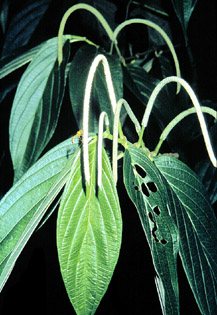|
Piper L.
Descriptions -- Digested by bats -- Dispersed by bats -- Notes -- Species treatments -- References Description. Shrubs or small trees, often of secondary habitats. Stems usually with swollen nodes. Stipules present or absent, when present caduceus, sometimes adnate to petiole. Leaves simple, alternate. Infructescences erect, arching spikes arising from nodes opposite leaves. Fruits drupes, indehiscent, one seeded, globose to oblong, greenish or whitish. Pericarp thin, mostly parenchymatous; exocarp and endocarp rich in oil-containing cells. Seeds broadly obovoid or square-globose, dorsiventrally flattened, 0.8 x 0.8 mm, brown or dark brown, glossy, the surface reticulate. Hilum small, in narrow depression; micropylar end with small conical tip; vascular bundle short, not reaching chalaza. Seed coat derived from two integuments, the testa crushed and absent in mature seed, the tegmen of 2-3 layers, the exotegmen of flat cells, the cells sometimes with crystals, the inner periclinal walls thickened, the mesotegmen a layer of large cells filled with brown pigment, the endotegmen present only at micropylar end. Perisperm copious, filling most of seed. Endosperm very small, restricted to micropylar end. Embryo globular, microscopic, not differentiated into organs. Digested by bats. The thin, fleshy, greenish or white-yellowish pericarp. Dispersed by bats. Seeds. Notes. Seeds of different species of Piper can be distinguished by using the following characters: size, shape, surface, and exotegmen and mesotegmen structure. Species treatments. P. aduncum. Charles-Dominique, P. 1991. Feeding strategy and activity budget of the frugivorous bat Carollia perspicillata (Chiroptera: Phyllostomidae) in French Guiana. J. Trop. Ecol. 7: 243-256. Cloutier, D. & D. W. Thomas. 1992. Carollia perspicillata. Mammalian Species 417: 1-9. Gorchov, D. L., F. Cornejo & C. F.Ascorra. 1995. Dietary overlap between frugivorous birds and bats in the Peruvian Amazon. Oikos 74: 235-250. dos Reis, N. R. & J.-L. Guillaumet. 1983. Les chauvees-souris frugivores de la région de Manaus et leur rôle dans la dissémination des espèces végétales. Rev. Ecol. (Terre et Vie) 38: 147-169. dos Reis, N. R. & A. L. Peracchi. 1987. Quirópteros da região de Manaus, Amazonas, Brasil (Mammalia, Chiroptera). Bol Mus. Par. Emilio Goeldi, sér. Zool. 3: 161-182. Fleming, T. H. 1988. The short-tailed fruit bat. The University of Chicago Press, Chicago. Marinho-Filho, J. S. 1991. The coexistence of two frugivorous bat species and the phenology their food plants in Brazil. J. Trop. Ecol. 7: 59-67. Willig, M. R. & M. R. Gannon. 1996. Mammals. Pages 403-413. In: D. P. Reagon & R. B. Waide, editors. The food web of a tropical forest. The University of Chicago Press. Chicago. |
